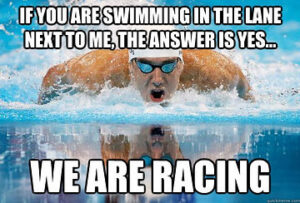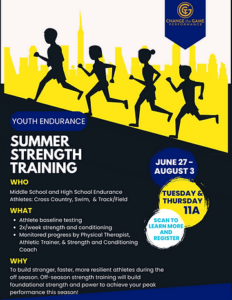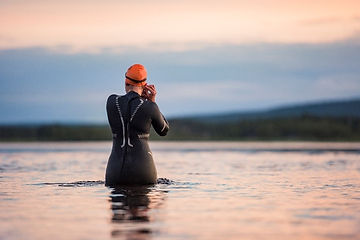If you’re registered for or just thinking about attempting a triathlon, you’re already familiar with the swim, bike, run format. But for most new triathletes, the question becomes, “How do I train for this?” followed quickly by, “What takes precedent in training?” In this three part series blog we will provide you with some basics of where to start your training plan for each of the 4 elements of tri training….including strength training. For each of these segments we will focus on training with INTENT. In our first post we started with the Bike and last time around we covered the Run. Now, let’s take it back to the beginning…..the SWIM.
Wading In

As you stand there knee deep in the ocean or lake or on the edge of a pool, you look around and see the mass of people who you’ll be swimming with. You may start to worry about the beating you can take in a mass start or going off course where there’s only a few buoys and boats to guide you, and you may even say to yourself, “Just get through this part and it’ll all be okay.” However, according to the research, winners of the triathlon come out in the first pack of swimmers 90% of the time for males and 70% of the time for females. That means that the swim is far more important than many triathletes think.
As you approach training for your first triathlon consider the fact that both the bike and run training are far more weight bearing than the swim; yet all three are highly aerobic and swimming has the added challenge of learning how to control your breathing that sometimes escapes us as we bike and run. Spending more time in the early part of our training on the swim can also reduce the risk of injury, because in the end your body is learning how to build endurance in all muscles and cannot tell the difference between the three modes.
Swimming may not be the most natural thing for you which may be another reason that you may choose to put this part of your training on the back burner. We know that the majority of triathletes come from the running or cycling fields and not swimming, so it tends to be their weakest link. Of those who do come from a swimming background, open water swimming may not be their forte. But we also know that we each want to feel strong and confident in the first or fortieth race, so let’s consider what we CAN do to become better at swimming.
Get Your Feet Wet!
Swimmers and triathletes take very different approaches to how they train in the pool and out of it, but there are a few tips we can all use to be more successful.
- Yardage Counts: Competitive swimmers are regularly putting in about 5-6000+ m per session about twice a day 5 or more days per week. There’s a reason they’re great swimmers. On average competitive triathletes are swimming 2500-3000m once per day about 2-3x/week. Consider how much yardage you need to get in the correct training for your race.
- Drills and Strokes: Many triathletes do a few drills in their warm-up and then go straight into putting in the yardage. Swimmers, on the other hand, mix drills in frequently throughout their practice. Top swim coaches suggest that 90% of a beginner triathlete’s swim workout should be drills and then the rest should be a Zone 2 efficiency swim. Even our most experienced triathletes would benefit from more drill work. AND it’s also beneficial to mix it up once in a while. Swimmers practice all 4 major strokes no matter their specialty or what they will be racing. Just as we’ve considered different types of runs and bike workouts in this series, consider different strokes as well. Try at least one set of IM or any stroke for each training session.
- Toys: We all know that triathletes love their gear, but fins, paddles, and pool buoys all have a very specific training purpose. Many swim coaches can tell you that it’s not likely that triathletes need to train with as many different tools in the pool as they may think.
- Off-Season: Swimmers compete almost year-round with meets popping up most weekends. Triathletes have a very limited season based on weather and their events do not lend themselves as easily to recovery. This makes off-season training even more important for beginner triathletes.

Again, swim workouts can offer a beginner triathlete some advantages in learning how to pace and breathe correctly in aerobic activities. It’s also important to consider workouts that match with the type of triathlon that you’re planning to compete in. Open water swims are something that can be very dangerous if not properly prepared; always practice open water swims with a partner and know the risks before going in.
More Than Swimmer’s Ear
For all it’s wonderful advantages, the swim also offers some challenges when it comes to training. The most notable is the higher risk of shoulder and neck injuries that can occur from the repetitive motion of swimming. Studies suggest that over 75% of swimmers report shoulder pain at some point and to varying degrees throughout their career. So, how do we combat this?
Most swim related shoulder injuries are due to any combination of the items on this list:
- Overtraining
- Not enough rest periods
- Poor stroke mechanics
- Poor breathing technique
- Poor flexibility or range of motion
- Decreased rotator cuff or shoulder blade (scapular muscle) strength
- Poor core strength or stability
- Decreased hip muscle strength
And almost all of them can be corrected, or even better – PREVENTED, by stability and mobility training.
Let’s Assess
Taking part in preseason and in-season strengthening and conditioning programs focused on improving strength (stability) and mobility in the:
Rotator cuff and scapular muscles to improve stability of the shoulders
Abdominals and other core muscle groups
And even the quads and hip flexors for kicks
can help improve the chances of avoiding injuries. Let’s start with mobility. Here Dr. Brandon demonstrates two different techniques for assessing mid-back mobility:
Final Tips
Since most of your swims in preparation for a triathlon will be freestyle, here’s a few tips on form to help you stay strong in your stroke:
-
- When breathing, keep the head in line with the body to avoid neck pain or numbness and tingling in the arms. (DON’T LOOK DOWN or FORWARD)
- Rotate the body toward the breathing side to avoid turning the neck too far and over-reaching with the arms. (SWIM WITH THE CORE)
- Breathe equally to both sides to prevent excess stress on one side of the neck. (USE ODD STROKES TO BREATHE)
And for your dryland training needs…..
CTG RUN STRONG and RUN STRONG VIRTUAL
Run Strong is a periodized program developed weekly to supplement your endurance training and ultimately change your approach to achieving higher levels of performance within running, triathlon and cycling training. This 2 day/week program will include exercises to develop strength, power, speed and hypertrophy at the appropriate time of the year to optimize performance. Prehab, injury reduction, and corrective exercises/ drills are a large emphasis to keep you training and at the highest level.
*NOW INCLUDES ADDITIONAL MOBILITY EXERCISES*
Share your favorite tris with us on
FB and IG!
Click here for Upcoming Triathlons in NC
check out our upcoming free workshop for endurance athletes

know a youth endurance athlete? have them sign up for our summer training session!



